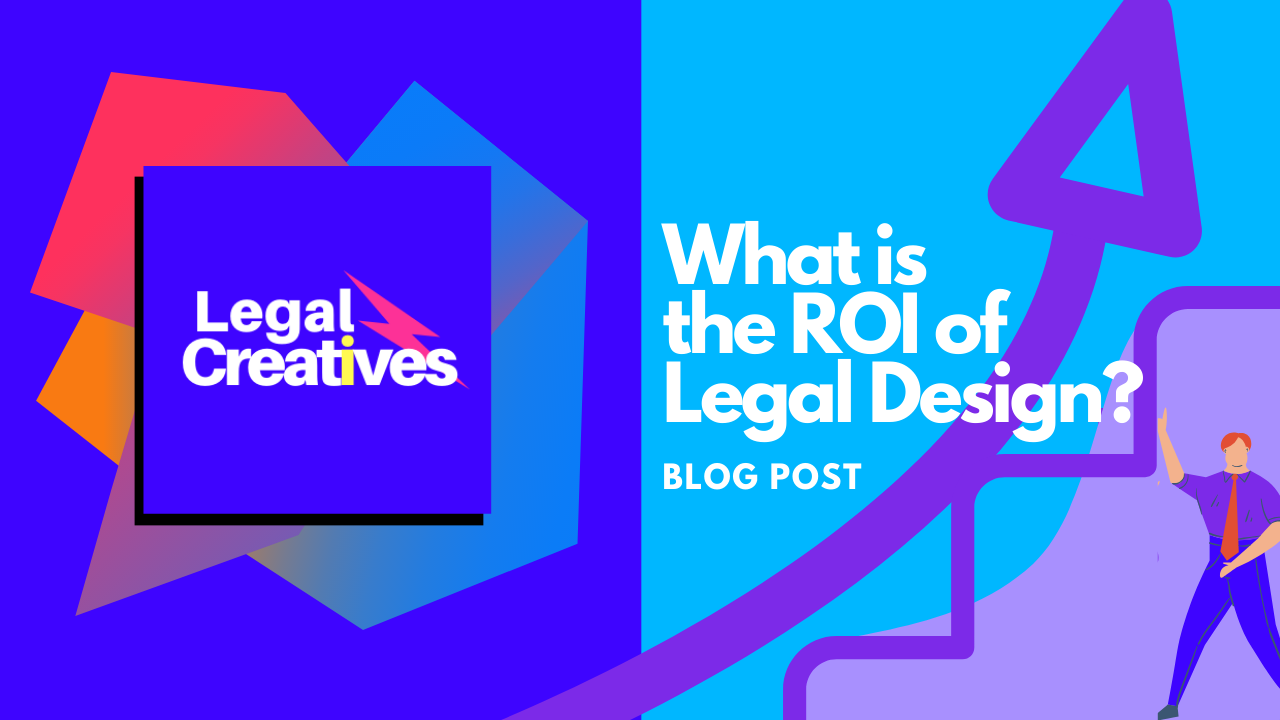What is the ROI of Legal Design?
Jun 01, 2020
With all that is going on today, there have been many choices of what to focus on. This is not a period where we can afford to stay on the surface nor to spend money on "nice to have" solutions. Products, softwares, consultancy and trainings that are not addressing core problems are no longer getting our attention anymore. These are times to save money or to accelerate growth to survive the crisis and thrive.
Is Legal Design another nice-to-have and is it a must-have investment? This what we tackled in one of our recent Legal Creatives newsletter that we are making available to you via this Blog. One thing is sure, the most innovative companies in the world share one thing in common: They use design as an iterative process to innovate more efficiently and successfully by focusing on the User Experience. So if you're eager to maximize the return of your investments, here are the most compelling findings from our research.
ROI Component #1: Money
According to research undertaken by Dr Susan Weinschenk, many projects fails due to poor user research that leads to user experience failures. In fact, up to 15% of projects are abandoned because they do not meet user needs. This equates to $150 billion wasted worldwide for the e-commerce industry alone. Her research also indicates that 50% of the time is spent reworking a project because of avoidable faults, leading compagnies spending 100 times more for fixing errors after development that could have been avoided in the first place. But there is more to that. According to IBM, “every dollar invested in ease of use returns $10 to $100." Staples increased their online revenues by 500% after their UX-focused site redesign. The Rockefeller Corporation, in a study on consumer behavior, found that 68% of consumers will switch to a company’s competitor when they don’t feel valued. Jared Spool, the founder of User Interface Engineering projected a simple tweak to the UI of Amazon that has contributed roughly $2.7 billion in revenue.
ROI Component #2: Time
What if you could increase the productivity of your team? By focusing on enhancing your user experience, you can. Mozilla saw a 70% decrease in support calls after spending about 14-weeks focusing on usability and iterative design. Dr Susan Weinschenk found in her research that “The amount of time that programmers spend on rework that is actually avoidable is 50 percent of their time.” Cutting down the number of tasks by simplifying workflows and processes geared towards a better user experience reduce inefficiencies, which in turn saves an incredible amount of time for businesses. National Trust's 9 step process got simplified to 5 steps or less, which in turn saved the Trust incredible amount of time in terms of employee labor.
UX is essential to business
Consider this statistic by DMI: Design-centered companies have outperformed the S&P by 228% in the last 10 years. However, irrespective of the benefits of focusing on the UX that are essential for sustaining growth and getting exponential outcomes, over 40% of the companies surveyed for McKinsey’s Report in The Business Value of Design aren’t talking to their end-users. In fact, 50% of companies surveyed do not conduct user research, which leads to poor User Experiences, loss of business opportunities, dissatisfied customers and a bad reputation. Not considering the User Experience leads to money loss and failed strategies for sustainable growth.
Legal UX, how to get started?
The processes for a Legal User Experience are the same processes required to build any competitive viable and sustainable business. But there is more to that: The design method needs to be adapted to the context of law. We have undertaken the translation of concepts for law thoroughly, which led to create a series of tools to process Legal Design, step by step.
Legal Design is not just about aesthetic and visuals. Legal Design a structured method and iterative process made to create incredibly attractive products and services for a new legal User Experience. It helps organizations gain a strategic positioning. A better legal UX increases team productivity as there will be no wasting time questioning different options or ideas. A better Legal UX also increases customer satisfaction and retention, as it makes product adoption easier. A better Legal UX can only be attained through Legal Design.
To start saving money and time, as well as gain more growth, Legal Design should be applied not just to focus the aesthetic elements nor trying to make law more comprehensible through visual law. It should be applied as a method to create incredible products and services. In a world saturated with products and fierce competition, the User Experience is the most critical factor in determining an organization’s success in market share, customer satisfaction and customer retention.
So let's focus on getting the biggest Legal Design ROI by using a user-centric method to create products, services and systems aimed to deliver the. There are data and metrics you need to track to get the best return on investment.
To help you achieve the biggest ROI with Legal Design, we are hosted a Virtual Meetup on June 3rd 2020. If you missed it, please subscribe to the newsletter to be invited to our next events.
We trust this article was useful to gain clarity as to the ROI of Legal Design, and if you'd like to get some of our tools to track your ROI and measure your success with Legal Design, we'd love to have you at our next events so please subscribe to the newsletter here!


